Content
Allium Gladiator - a hybrid form of the crop created on the basis of Aflatun onion and the Makleana variety. A tall, perennial plant with large flower stalks is grown not only for garden design, but also for cutting.
Description
Allium Gladiator is a high variety of culture. The plant is frost-resistant, suitable for gardens in temperate climate zones. The perennial crop is unpretentious in care and calmly responds to moisture deficiency and unstable spring temperatures.

Allium Gladiator can grow on a site for more than 7 years
After planting with seeds, it reaches reproductive age in the third year of the growing season. Reacts calmly to direct sunlight and partial shade. The wild allium species is endemic and is attached to clay soils. This feature was passed on to all hybrid forms.
Biological characteristics of allium Gladiator:
- The height of the decorative bow is 120 cm.
- The leaves are formed in the lower part, the plates are narrow and elongated with pointed tips. The surface is plain bright green, smooth, glossy. The leaves are edible, with a pungent garlic odor.
- The peduncles are round, hollow inside, strong, rigid, do not bend from the wind, and are a shade lighter than the leaves.
- A large spherical inflorescence with a diameter of up to 25 cm is formed at the top of the stems.
- The flowers are small, star-shaped, six-petaled, collected in numerous umbrella-shaped inflorescences, the dense arrangement of which forms a ball.
- The color of the petals is blue-violet, the core is green.
- The bulb is oval, with numerous children, up to 3.5 cm in diameter. The inner part is beige, the scales are parchment, dark brown.
If there is an excess of water, the Gladiator allium bulb will quickly rot, and it will be impossible to save the plant.
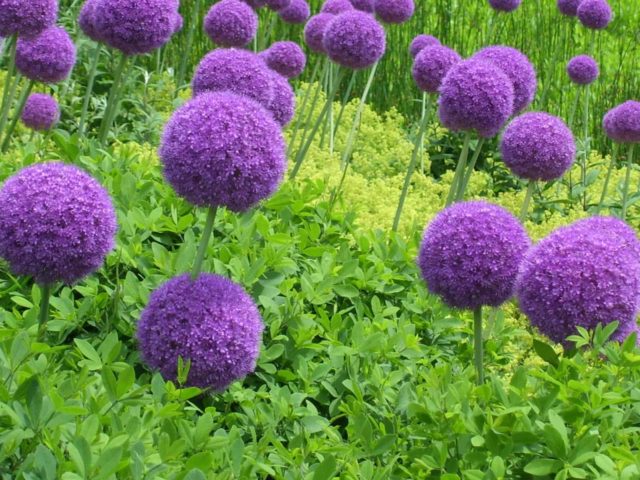
Allium Gladiator blooms at the end of May, cycle duration is 1.5 months
Growing from seeds
The flowers are bisexual, so the decorative onion Gladiator provides valuable material for generative propagation. Collect seeds after allium blooms, when they begin to fall off. If the material is not ripe, it will not sprout. After collection, place in a cloth bag and place in the refrigerator. In spring, you can sow allium Gladiator in a flower bed. This method of propagation is used only for mass cultivation of planting material.
At home, the method is not productive; from the moment the seeds are planted until the Gladiator allium blooms, it will take 3-4 years. The initial growing season is aimed at the formation of the bulb; when it reaches the required size, the plant will form an arrow and bloom.
To speed up the time before allium Gladiator blooms, you can grow seedlings:
- Seeds are planted immediately after collection.
- Fill the containers with a mixture of clay, sand and compost, add calcium.
- Sow the material in shallow furrows.
- Water and place in a room at a temperature of +20 0
- In a favorable environment, the seeds will germinate in 3 weeks.
- They are left indoors until spring, watered periodically.
- In March, they begin to harden allium and gradually lower the temperature.
- At the time of planting, the temperature regime should coincide with that of the open area.
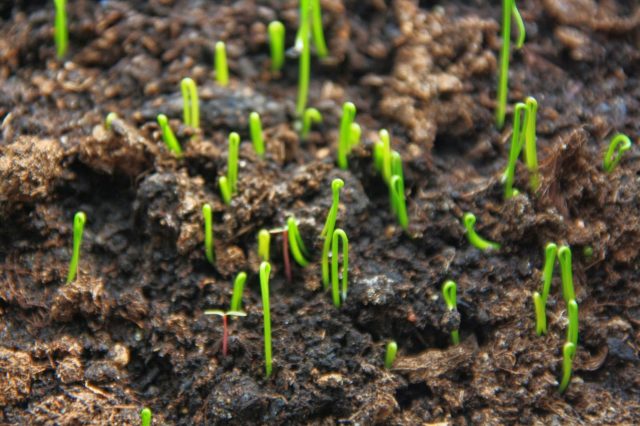
Allium Gladiator is not planted in separate containers; such a procedure is undesirable for bulbous crops
How and when to plant in open ground
Allium Gladiator is planted in open ground in the spring or at the end of the season. The plant takes root well and overwinters, and is not afraid of return frosts, so there are no advantages in choosing the time to carry out the work. The timing is based on the weather conditions of the region. In spring the earth should warm up to +8 0C, in autumn the air temperature should not be below +100C.
Sequence of work:
- The soil is dug up, a nutrient mixture and ash are added.
- Make a hole for seedlings 10*10 cm. For a bulb, the depth should be 3 times greater than the height of the planting material.
- Requirements for deepening depend on the growing method. If the material is not dug out for winter storage indoors, drainage is not installed. If left on the site, then the bottom is covered with pebbles of the middle fraction.
When mass planting, maintain an interval of 20-30 cm between decorative onions.
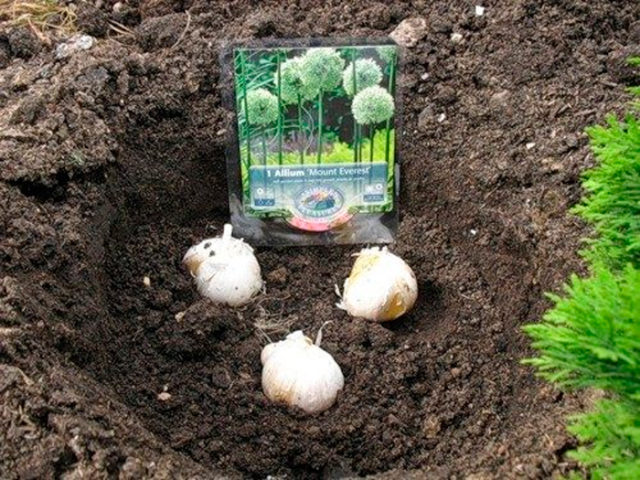
You can place several bulbs in one hole to make the bush dense
The plant is not mulched so that the material does not retain excess moisture, especially during the rainy season.
Care
Agricultural technology of allium Gladiator consists of the following activities:
- Mandatory loosening of the soil for better enrichment with oxygen, this measure is especially relevant in the first years of the growing season, when the bulb is formed.
- Constant removal of weeds, the event is of an aesthetic nature and relieves decorative onions from the threat of fungal infection.
- The plant is watered only during the dry season; generally allium has enough rainfall. The crop responds better to dry soil than to waterlogged soil.
- Fertilizing is a mandatory condition; it is given to the crop throughout the entire season. Nitrogen is added in spring, complex mineral fertilizers are added during flowering, and calcium and phosphorus are needed in early autumn.
- After flowering, the above-ground part dies off and is removed before the onset of frost.
If the bulbs are left on the site, they are covered with peat mixed with organic matter. In cold regions, the underground part is dug out and stored at a temperature no higher than +4 0C.
Diseases and pests
Allium Gladiator is a hybrid variety that gets sick if agricultural conditions are not met.
In unfavorable conditions for growth, it can be affected by neck rot. The first foci of infection appear on dying leaves in the fall. The bulb will not survive until spring if left in the soil. Therefore, the underground part is dug out, dried in the sun and subjected to heat treatment. Turn on the oven at 48-50 0C, place the bulbs on a baking sheet and leave for 60 minutes.
Tobacco thrips is a pest that parasitizes allium. Insecticides are used to control insects. The main threat is the larvae of the onion fly. They get rid of pests with Aktara.

For preventive purposes, allium Gladiator is treated in early spring and at the first signs of the appearance of larvae
Reproduction
Allium Gladiator is propagated by seeds, direct planting in the ground or seedlings. The material can be sown in a flowerbed in late autumn, it will undergo natural stratification and sprout in the spring. Work can be carried out in early spring; seedlings are placed on the site at the beginning of the growing season.
At the initial stage, you can purchase bulbs in a specialized store. In 3 years, children will grow around them. They are separated and planted in a flower bed. The procedure is carried out at the beginning of the season or after flowering. If allium is dug up for the winter, then the planting material is divided at the beginning of the growing season.
Photos in landscape design
The Gladiator hybrid is used to decorate park areas, gardens and personal plots as a decorative element. It can be grown in a container as an annual plant and decorated in any corner of the garden or veranda.
When composing a composition for a flower bed, take into account that the decorative part of the plant is tall peduncles and large purple balls of inflorescences. Leaves with drooping tops and dark spots on the surface are not of particular value, and sometimes even spoil the overall picture. Therefore, during mass planting, they are combined with plants that cover the leaf zone in height.
A few examples with photos of how you can use allium Gladiator in gardening:
- Mixborder with ephedra and low-growing flowering and ornamental crops.
- Creating a high border along the edge of the garden path.
- Solo in the center of the rockery in a joint planting with hosts.
- Allium as the central accent of the composition in combination with daylily and flowering plants.
- Option for decorating a lawn using allium Gladiator.
Conclusion
Allium Gladiator is a tall hybrid variety of crop.A plant with large bright purple inflorescences is used in the design of gardens, plots, and in floristry. Allium is unpretentious to grow, frost-resistant, and does not respond to lack of moisture. The perennial plant is propagated by seeds and bulbs.
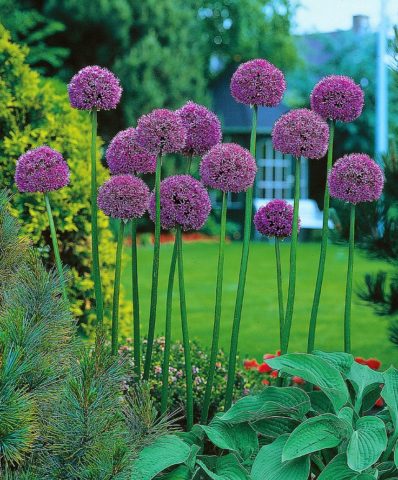
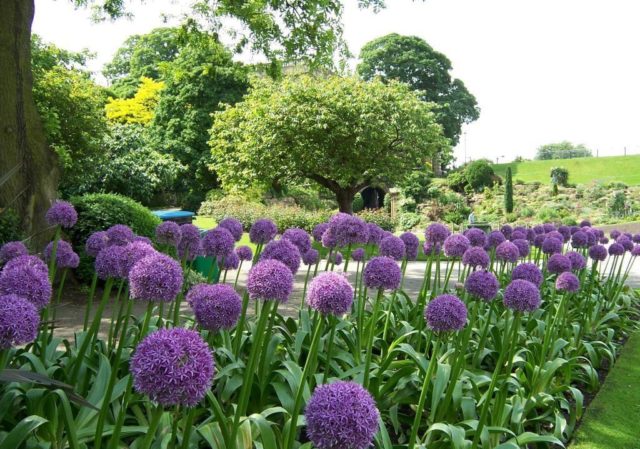
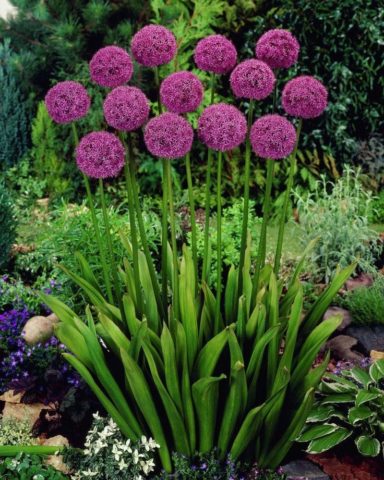
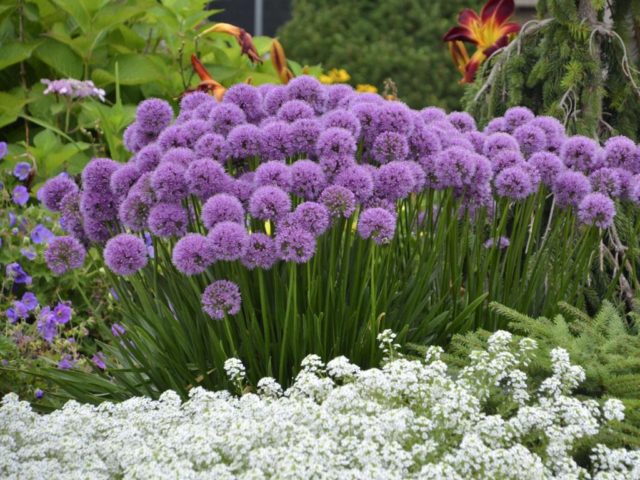
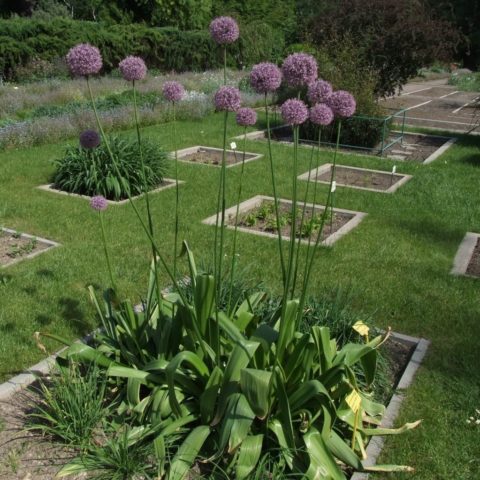
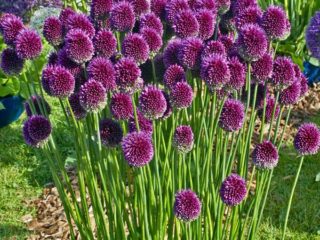

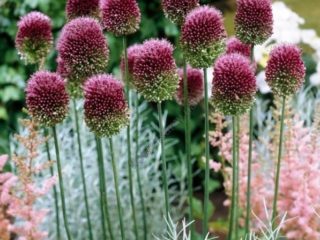
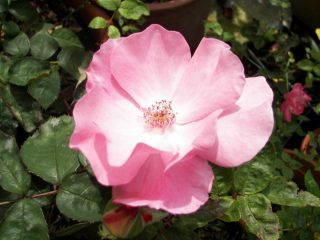


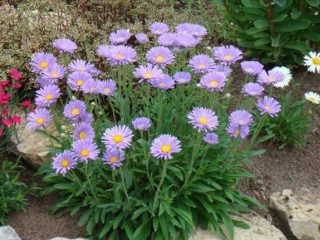

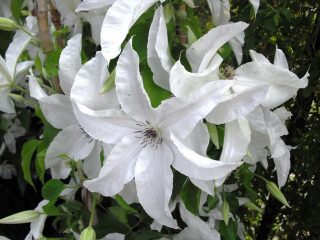
When and how to plant an onion. I have only one. Should I plant it in the fall or wait until spring?